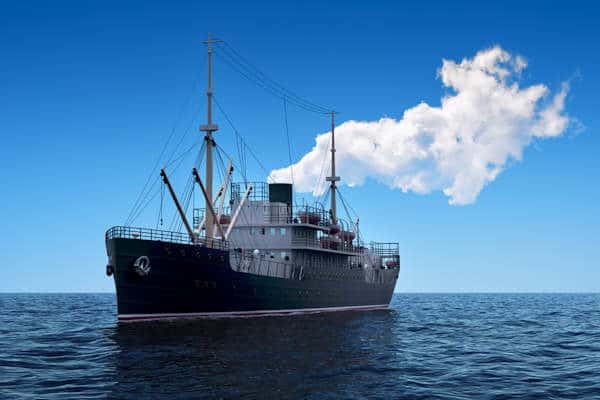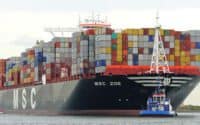Slow Steaming in the Cargo Ship Industry: A Sustainable Shift with Ripple Effects

The Mechanics of Slow Steaming
Slow steaming refers to the operational practice where ships, particularly large cargo vessels, deliberately reduce their speed to below their maximum capability. This isn’t just a matter of turning a dial; it requires careful calibration of the ship’s main engine and various systems to ensure safe and efficient operation at these reduced speeds.
* Please send feedback/suggestions to editor @ shipuniverse.com
Fuel, Emissions, and the Maritime Industry
Fuel consumption doesn’t scale linearly with speed. As a ship’s speed increases, the power required—and thus fuel consumed—rises exponentially. This relationship makes reducing speed a powerful tool for conserving fuel.
Background: Unraveling the Drive for Slow Steaming
Global Environmental Landscape
The world is grappling with an environmental crisis. Climate change, driven by the accumulation of greenhouse gases in the Earth’s atmosphere, has led to erratic weather patterns, rising sea levels, and increased global temperatures. The imperative is clear: reduce emissions or face increasingly dire consequences.
The Regulatory Response
Recognizing this, international regulatory bodies, like the International Maritime Organization (IMO), have stepped in. The IMO, in particular, has set stringent targets to reduce the maritime sector’s greenhouse gas emissions. These regulations are not merely recommendations; they come with implications for non-compliance, pushing shipping companies to adopt practices like slow steaming as a method to meet these targets.
What is Slow Steaming?
Digging into the Mechanics
At its essence, slow steaming is an operational strategy wherein vessels limit their propulsion power, resulting in significantly reduced speeds. This isn’t merely about cruising at a leisurely pace; it’s a calculated move to optimize engine performance, fuel consumption, and emissions output.
A Spectrum of Speeds
There’s no one-size-fits-all in slow steaming. It’s more of a gradient:
- Super Slow Steaming: Here, vessels operate at around 30-40% of their full speed. While it offers maximal fuel savings, it also extends transit times considerably.
- Extra Slow Steaming: A middle ground, where ships cruise at about 40-50% of their maximum capacity. It balances between fuel efficiency and delivery timelines.
- Slow Steaming: Operating at roughly 50-75% of top speed, this mode seeks to strike a harmonious blend of operational efficiency and timely cargo delivery.
A Glimpse into the Past
The concept isn’t as modern as one might think. During global oil crises, with soaring fuel prices, the maritime industry had to innovate. Slow steaming emerged as a solution, not just for cost-cutting but also for navigating periods of fuel scarcity.
Benefits of Slow Steaming
For Planet Earth
- Clearer Skies: By limiting engine power, vessels release fewer pollutants. We’re talking significant reductions in carbon dioxide (CO2), sulfur oxides (SOx), and nitrogen oxides (NOx). In layman’s terms, it’s like switching from a gas-guzzling truck to a fuel-efficient sedan.
- Oceanic Preservation: It’s not just about the air. Lesser pollutants mean reduced acidification of oceans, promoting the health and diversity of marine life. Imagine it as giving a much-needed break to coral reefs and marine habitats.
For the Ledger Books
- Fuel Frugality: Reduced speeds equate to exponential fuel savings. It’s akin to driving a car at 45 mph consistently, which usually offers better mileage than erratic speeding.
- Longevity for Vessels: Slow steaming tends to extend the lifespan of the ship’s machinery. Think of it as avoiding redlining your car’s engine; the machinery faces less wear and tear over time.
For Ship Operations
- Ease on Engines: By operating below maximum capacity, engine stress is considerably lowered. This equates to fewer overhauls and extended periods between maintenance checks.
- Maintenance Benefits: Fewer breakages, lesser replacements. With systems operating below their peak, the frequency and intensity of maintenance routines are reduced, resulting in cost and time savings.
Challenges and Implications of Slow Steaming
1. Navigating Supply Chain Dynamics
- A Race Against Time: Slowing down ships isn’t without trade-offs. Perishable goods, such as agricultural produce or pharmaceuticals, rely on timely deliveries to maintain product integrity. When ships slow down, these items face extended transit times, risking decreased shelf life and potential wastage. Think of it as the challenges faced by refrigerated trucks, but on a much grander, oceanic scale.
- Stocking Up Costs: Longer shipping times might compel businesses to keep more stock on hand, resulting in increased warehousing and inventory costs. This could be likened to buying in bulk to anticipate a delay in your next delivery—only, on an industrial scale.
2. Technical Troubles on Deck
- Retuning the Giants: Cargo ships were designed for specific operational parameters. Slow steaming requires recalibrating engine settings, altering fuel injection timings, and possibly retrofitting with new equipment to maintain efficiency at reduced speeds.
- The Chill of “Cold Corrosion”: This isn’t your everyday rusting. When ships reduce their speed, certain parts of the engine can operate at lower temperatures than designed for, leading to condensed water droplets. These droplets can cause accelerated wear and tear in cylinders—termed “cold corrosion”. Imagine driving a car in harsh winter without proper antifreeze; the engine could suffer.
3. Balancing Stakeholder Aspirations
- Ticking Clocks and Calendars: In a world driven by rapid e-commerce and tight delivery schedules, customers have grown accustomed to timely deliveries. Slow steaming, by its nature, challenges this pace.
- Striking the Right Balance: The maritime industry stands at a crossroads, juggling the need for speed, operational efficiency, and the ever-growing demand for environmental sustainability.
A Closer Look: Slow Steaming Case Studies
- Industry Titans Leading the Way: Several of the world’s top shipping lines have not only tested the waters of slow steaming but have embraced it. Their journeys offer invaluable insights into the practice’s viability. Four case studies.
- Navigational Notes: Like any transformative strategy, there have been learning curves. The industry’s experiences offer a roadmap of best practices and lessons to circumnavigate potential pitfalls.
Alternative Solutions and the Future of Slow Steaming
1. Fuelling the Future Differently
- Alternative Propellants: The maritime industry is not tethered solely to traditional fossil fuels. There’s considerable research and development into alternatives like biofuels, liquified natural gas (LNG), and hydrogen. Imagine swapping out gasoline in cars for electricity; the shipping world is undergoing its own version of this transition.
- Nuclear Considerations: There’s also growing discourse around nuclear propulsion, much like submarines or aircraft carriers. The technology promises immense energy without emissions, but the debate around safety, waste management, and public perception persists.
2. Setting Sail with Advanced Tech
- Automated Navigation and AI: Imagine a ship that can autonomously chart the most fuel-efficient route, leveraging AI algorithms. This isn’t sci-fi; it’s on the horizon. These tech-driven navigation systems promise to enhance fuel efficiency without necessarily compromising speed.
- Energy-Efficient Ship Designs: Engineers are reimagining ship designs. From sleeker hulls that reduce drag in water to incorporating solar panels and sails, the ships of the future might look and operate quite differently from their predecessors.
3. Slow Steaming’s Longevity Debate
- Temporary Fix or Lasting Solution? While slow steaming offers undeniable benefits in emissions reductions and fuel savings, one must question its long-term viability. As technological advancements provide alternative solutions, the shipping industry might pivot, rendering slow steaming a transitional strategy.
1. Slow Steaming’s Ripple Effect
- A Global Trade Perspective: Slow steaming does more than just alter ship speeds; it reverberates throughout the global trade ecosystem. From influencing supply chain strategies to shaping international trade agreements, this practice has ushered in a paradigm shift.
- Green Ambitions: In the face of a looming environmental crisis, slow steaming has been a testament to the shipping industry’s commitment to sustainability. It stands as a beacon, showcasing how industries can adapt and innovate for the planet’s well-being.
2. Navigating Tomorrow’s Waters
- Charting a Sustainable Course: Whether slow steaming remains prevalent or fades as newer solutions emerge, the key takeaway is the industry’s acknowledgment of its environmental footprint. The journey ahead isn’t just about moving cargo; it’s about moving towards a greener, more sustainable future, one nautical mile at a time.

Do you have a Maritime Product or Service that may be of interest to Shipowners? Tell us about it here!
Do you have feedback or insights? Please reach out to editor @ shipuniverse.com



